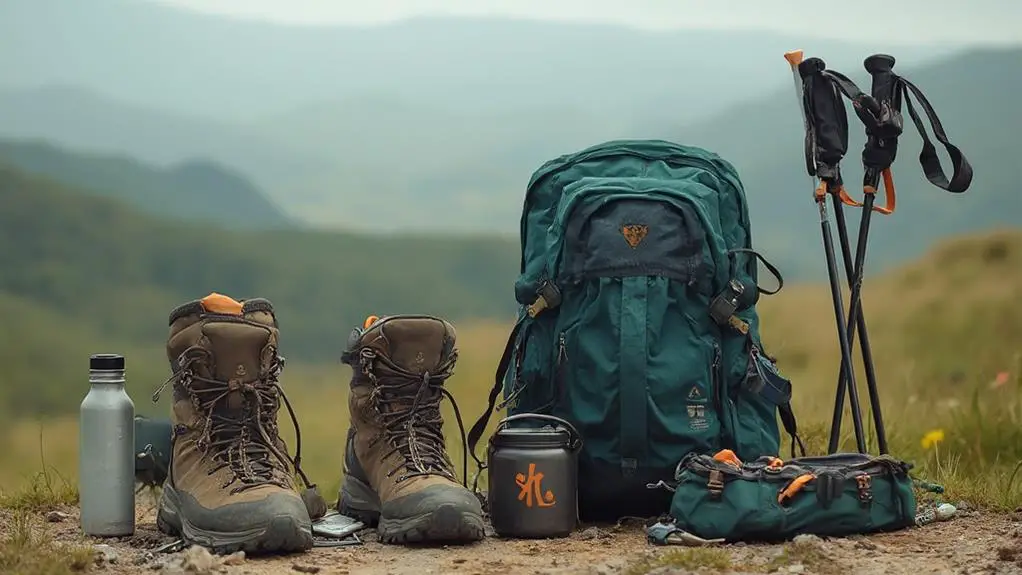Starting a hiking journey involves selecting a trail that matches your fitness level, ideally under 5 miles, and preparing essential gear including sturdy footwear, a 15-30 liter backpack, and hydration solutions. Proper clothing, with weather-adaptive layering and moisture-wicking fabrics, is vital. Always check trail conditions and weather forecasts beforehand. Equip yourself with navigation tools like GPS devices and maps, and inform someone of your itinerary for safety. Understanding the physical and mental benefits of hiking, along with effective trail selection and preparation, enriches your hiking experience, leading to further insights and enjoyment along the trails.
Key Takeaways
- Begin with beginner-friendly hikes under 5 miles to match your fitness level and experience.
- Research trails using reliable resources like AllTrails for accurate trail conditions and difficulty ratings.
- Pack essential gear, including a sturdy backpack, comfortable footwear, and hydration tools.
- Dress in layers with moisture-wicking and weather-appropriate clothing to manage varying conditions.
- Inform someone about your hiking plan and carry a first aid kit for safety and emergency preparedness.
Understanding Hiking Basics
To commence a successful hiking journey, a foundational understanding of the activity's basics is essential. Hiking, with its rich history dating back to early explorers and naturalists, is defined as walking for pleasure across diverse natural settings. It is typically pursued on established trails within mountains, beaches, and forests.
Selecting a trail that aligns with your fitness level is imperative—beginner-friendly hikes are generally under 5 miles and offer minimal elevation gain, guaranteeing a safe and enjoyable experience.
Trail conservation plays a critical role in hiking, emphasizing the importance of following designated paths. This practice not only safeguards your safety but also protects the environment, preventing erosion and damage to natural habitats.
Thorough preparation is key to a successful hike. This includes researching your trail options, checking weather forecasts, and equipping yourself with appropriate gear such as sturdy footwear, navigation tools, and adequate hydration supplies.
Understanding these basics, along with a commitment to preserving the trails, guarantees that hikers can enjoy the myriad physical and mental benefits of the activity. This knowledge forms the cornerstone of safe and responsible hiking, fostering a connection with nature that has been cherished for centuries.
Benefits of Hiking

Initiating a hiking expedition offers a multitude of benefits that extend beyond mere physical exercise. Hiking serves as a thorough full-body workout, capable of burning between 430 to 480 calories per hour, which greatly enhances cardiovascular fitness.
More than just a physical activity, hiking is a boon for mental health. Regular participation in hiking has been shown to alleviate symptoms of anxiety and depression. Immersing oneself in nature has a profound effect on mental well-being, promoting happiness and reducing stress levels.
In addition to mental health benefits, hiking is instrumental in fostering social connections. It is often a group activity, providing opportunities to build friendships and engage with a community of like-minded individuals. This social aspect enhances a sense of belonging and support, which is crucial for overall well-being.
From a physical health perspective, hiking aids in improving bone density and joint health, essential for reducing the risk of osteoporosis.
The cognitive benefits are equally compelling; hiking has been linked to improved memory and attention span, bolstering brain health. For beginners, these multifaceted benefits underscore the value of incorporating hiking into one's lifestyle while adhering to safety practices for ideal enjoyment.
Selecting the Right Trail
Selecting the right trail is vital for a safe and enjoyable hiking experience, particularly for beginners.
Start by evaluating the difficulty of the trail, ensuring it aligns with your fitness level, and aim for routes under 5 miles with minimal elevation gain.
Utilize reliable resources such as AllTrails and Hiking Project to gather essential information on trail length, elevation changes, and current conditions, and always verify the latest reviews to avoid unexpected hazards.
Assess Trail Difficulty
Choosing the right hiking trail is an essential aspect of ensuring both safety and enjoyment in your outdoor adventures. For beginners, understanding trail rating systems and evaluating fitness levels are critical steps in this process.
Trail rating systems, such as those found on platforms like AllTrails and Hiking Project, provide valuable insights into trail difficulty by considering factors like distance, elevation gain, and terrain type. These ratings, often classified as easy, moderate, or difficult, can guide you in selecting trails that align with your current fitness level and hiking experience.
When evaluating your fitness, start with honest self-reflection on your physical capabilities. Beginners are generally advised to choose trails under 5 miles with minimal elevation gain to maintain an enjoyable experience.
Starting with flat or well-maintained paths is prudent before gradually tackling more challenging terrain. Additionally, checking trail conditions through local park websites or ranger stations is a safety-focused practice, as weather and seasonal changes can alter trail difficulty considerably.
Consider Trail Length
When initiating a hiking journey, understanding the importance of trail length is essential for both safety and enjoyment. Selecting an appropriate trail length can greatly influence your hiking experience, especially as a beginner. It is advisable to start with trails under 5 miles, focusing on routes with minimal elevation gain to guarantee a manageable and enjoyable outing. This approach helps you become accustomed to the physical demands of hiking, allowing you to gauge your personal stamina and adjust your distance goals accordingly.
Furthermore, evaluating the total distance involved in a hike is critical, as it directly impacts the difficulty and the physical endurance required. Utilizing trail guide resources such as AllTrails and GaiaGPS can be instrumental in identifying beginner-friendly hikes. These platforms provide detailed trail information, helping you understand expected conditions and precise trail lengths.
As you gain fitness and confidence, you can gradually extend the distance of your hikes. Setting realistic distance goals is important to prioritize enjoyment and mitigate the risk of overexertion. By aligning trail selections with your fitness level, you foster a safer and more pleasurable hiking experience, laying a solid foundation for future adventures.
Check Elevation Gain
Beyond trail length, another important consideration is the elevation gain of a hiking trail, which plays a significant role in determining its difficulty level. Elevation gain refers to the cumulative vertical distance you will ascend during your hike, and it's essential for evaluating how physically demanding a trail may be.
Beginners are advised to start with trails that feature an elevation gain of under 1,000 feet. This choice allows for a manageable yet challenging experience that aids in building endurance without overexertion.
Understanding elevation profiles is vital when planning your hike. Resources like AllTrails and Hiking Project offer detailed elevation profiles and total gain statistics for numerous trails. These tools can guide your selection process by providing insights into how a trail's elevation changes over its course.
A flat trail might appear less intimidating compared to one with significant elevation variations, even if both are of comparable length.
Conducting a personal fitness evaluation is indispensable before selecting a trail. Recognizing your current fitness level helps you choose an elevation gain that matches your capabilities.
Gradually increasing elevation gain as your strength improves will enhance your hiking experience and help prevent fatigue and injury.
Essential Gear Checklist

Before setting out on a hiking adventure, equipping yourself with the right gear is vital for both safety and comfort. A sturdy backpack, ideally between 15-30 liters for day hikes, guarantees you have ample space for necessities while maintaining ease of movement.
Gear maintenance is important; regularly inspect your equipment for wear and tear, particularly your backpack and footwear. Comfortable, supportive hiking boots or trail runners are indispensable, providing the stability needed on varying terrains.
Hydration strategies are essential. Carry a minimum of one liter of water for every two hours of hiking. A hydration pack offers convenience, allowing easy access to water without pausing your stride.
In addition, packing the Ten Essentials—such as a map, compass, first-aid kit, multi-tool, fire starter, headlamp, extra food, and clothing layers—strengthens your preparedness against unexpected situations.
Navigation tools, including a GPS device or smartphone app like AllTrails, are invaluable in unfamiliar areas. For sustained energy, stock snacks like trail mix or energy bars, aiming for 200-300 calories per hour.
This thorough gear checklist guarantees a safe and enjoyable hiking experience, fostering confidence and readiness on the trail.
Dressing for the Trail

Selecting the right footwear and clothing layers is essential for a safe and comfortable hiking experience.
When tackling different terrains, choose footwear that provides the necessary support and traction, such as hiking boots for rugged trails or trail runners for smoother paths.
Layering is equally important to manage varying weather conditions, starting with a moisture-wicking base layer, adding warmth with an insulating layer, and using a waterproof outer layer as needed.
Choosing Appropriate Footwear
For anyone venturing into the world of hiking, choosing the right footwear is a significant step in guaranteeing both comfort and safety on the trail. Selecting footwear with appropriate materials is vital; hiking boots made from durable leather or synthetic fabrics provide essential ankle support and traction for rugged terrains, while trail runners with breathable mesh are well-suited for well-maintained paths.
Understanding different boot styles can help in making an informed choice—mid-cut boots offer more stability, while low-cut shoes offer increased flexibility.
To guarantee an ideal hiking experience, consider the following expert tips:
- Avoid Cotton: Cotton retains moisture, which can lead to blisters. Opt for moisture-wicking socks composed of synthetic materials or merino wool to keep your feet dry.
- Proper Fit: Try on hiking shoes with the socks you intend to wear on the trail, guaranteeing a thumb's width of space between your longest toe and the shoe's front.
- Match Footwear to Terrain: Heavier boots are ideal for challenging terrains, while lighter shoes cater to easier, shorter hikes.
- Break Them In: Gradually break in new footwear with shorter walks to prevent discomfort on longer hikes.
Adhering to these guidelines will guarantee a safe and enjoyable hiking experience.
Layering for Weather Changes
Layering is a fundamental strategy in hiking that enables hikers to adapt to varying weather conditions, thereby ensuring comfort and safety on the trail. Utilizing effective weather adaptation strategies, hikers can achieve ideal body temperature regulation, preventing both overheating and chills.
The layering system begins with a moisture-wicking base layer, which plays an essential role in managing perspiration. Comparing layering materials, polyester and merino wool emerge as superior choices for this foundational layer due to their ability to efficiently transport moisture away from the skin.
The insulating mid-layer, typically composed of fleece or down, serves to retain body heat. This layer is versatile, allowing for adjustments or removal as needed, depending on the hike's temperature fluctuations.
The final piece in this strategic ensemble is the weather-resistant outer layer. A jacket that is both waterproof and breathable shields the hiker from wind, rain, and snow, ensuring they remain dry and comfortable regardless of inclement weather.
For lower body protection, breathable, quick-drying pants are recommended. In particularly wet or variable conditions, gaiters can offer additional defense against mud and moisture, enhancing the effectiveness of your overall weather adaptation strategies.
Navigation and Maps

Maneuvering the great outdoors effectively requires a blend of modern technology and traditional methods to secure safety and reliability. Digital navigation tools, such as GPS devices and apps like GaiaGPS, are invaluable for real-time tracking and accessing trail information.
However, relying solely on technology can be risky due to potential battery failure or signal loss. Complementing digital navigation with traditional topographic maps enhances preparedness, as these paper maps detail elevation changes and terrain features, building both skill and confidence in your navigation abilities.
To guarantee a successful hiking experience, consider the following expert tips:
- Dual Approach: Use both digital navigation and topographic maps to create a reliable navigation system.
- Offline Preparation: Download maps for offline use before your hike, securing access to vital information even in remote areas.
- Battery Management: Conserve battery life by switching your device to flight mode when navigation isn't needed, preventing unexpected power loss.
- Map Preservation: Print guides and maps, storing them in Zip-Lock bags to protect against moisture and wear, ensuring durability throughout your journey.
Adhering to these navigation principles not only enhances safety but also enriches your hiking adventure, allowing you to explore with confidence and peace of mind.
Weather Considerations

When planning a hike, it is essential to monitor mountain-specific weather conditions, as they can vary greatly from nearby urban forecasts and impact trail safety.
Dressing in layers is advisable to accommodate fluctuating temperatures, allowing for quick adjustments as conditions change.
Additionally, always check for trail closures due to adverse weather or maintenance to guarantee a safe and accessible hiking experience.
Monitor Weather Conditions
Before starting on a hiking adventure, it is essential to diligently monitor weather conditions to guarantee a safe and enjoyable experience. Utilizing weather apps can greatly enhance your preparedness by providing forecast accuracy specific to your hiking location. These apps often offer real-time data and alerts, allowing hikers to make informed decisions before and during their trek.
It is important to check both mountain-specific forecasts and local weather reports, as conditions can vary considerably between these areas.
In addition to digital resources, reviewing park websites for trail closures or warnings is a key step. Weather can impact not only trail conditions but also accessibility, so staying informed will help prevent unexpected surprises.
Here are four reasons why monitoring weather conditions is indispensable:
- Safety: Unpredictable weather can lead to hazardous situations, such as reduced visibility or slippery trails.
- Preparation: Knowing what to expect enables you to pack appropriately, ensuring you have necessary gear like rain protection.
- Time Management: Planning hikes within daylight hours is important, especially when weather may reduce visibility.
- Adaptability: Real-time updates via a portable weather radio or smartphone app allow you to adjust your plans as needed.
Always prioritize your safety by staying informed.
Dress in Layers
Dressing in layers is an essential strategy for managing weather variability and guaranteeing comfort and safety during hiking. Effective layering techniques enable hikers to regulate temperature efficiently, adapting to changing conditions and exertion levels.
Begin your attire with a moisture-wicking base layer, which removes sweat from the skin, thus preventing chills. Opt for materials like merino wool or synthetic fabrics, which outperform cotton by providing superior insulation and moisture management.
The next step involves the insulating layer, such as fleece or down, which retains body heat. This is critical for maintaining warmth during cooler conditions.
For the outermost layer, choose a waterproof and windproof shell that shields against rain and wind, integral to preserving body warmth and dryness.
In unpredictable weather, carrying an additional layer, like a lightweight jacket or thermal top, allows you to respond swiftly to temperature drops or unexpected showers.
Moreover, accessories like hats, gloves, and neck gaiters offer added protection against wind chill, enhancing your comfort without adding bulk.
Check Trail Closures
Amidst the excitement of planning a hiking adventure, it is vital to prioritize safety by checking trail closures before setting out. Trail updates can be obtained through official park websites or local ranger stations, guaranteeing you are aware of any closures due to weather conditions, maintenance, or hazards.
Many parks now use social media platforms to provide real-time trail updates, making it imperative to follow these accounts for the latest information. Unexpected weather changes, such as heavy rainfall leading to landslides or snow accumulation making trails impassable, can result in sudden closures.
To guarantee you are fully prepared, consider the following steps:
- Check official park websites: These platforms often provide detailed information on trail status and any wildlife advisories.
- Follow park social media accounts: Stay informed on current trail conditions with real-time updates.
- Consult hiking apps like AllTrails: User-reported trail conditions can offer valuable insights into recent closures or warnings.
- Be aware of seasonal wildlife activity: Understand that trails may be closed due to nesting or calving seasons, communicated through park advisories.
Hydration and Nutrition

For a successful hiking experience, prioritizing hydration and nutrition is essential to maintain energy and overall well-being on the trail.
Effective hydration tips include carrying at least one liter of water for every two hours of hiking, particularly in warmer conditions. Utilizing a hydration pack offers convenience, allowing hands-free access to water, which can be significant while maneuvering through challenging terrains.
It's important to monitor hydration status by remaining vigilant for symptoms like dizziness, dry mouth, or fatigue, indicators of potential dehydration.
Incorporating appropriate nutrition sources is equally important. Aim to consume 200-300 calories per hour of hiking by packing lightweight, nutrient-dense snacks.
Options such as trail mix, energy bars, or dried fruit provide sustained energy levels without adding excessive weight to your pack.
Planning hydration stops along your route is a prudent measure, ensuring awareness of available water sources for safe refilling.
Safety and Emergencies

When starting on a hiking adventure, prioritizing safety and being prepared for emergencies is vital.
Begin by notifying someone you trust about your hiking itinerary and consider carrying essential safety gear, such as a personal locator beacon for reliable communication in remote areas.
Additionally, equip yourself with a basic first-aid kit and knowledge of treating common injuries, ensuring you can address minor mishaps and recognize signs of serious conditions like altitude sickness.
Essential Safety Gear
Starting on a hiking adventure requires meticulous preparation, especially regarding safety and emergency gear. Equipping yourself with the right hiking gear is essential to guarantee a safe and enjoyable experience on the trails. Here are some vital safety tips to take into account:
1. First Aid Kit: Carry a first aid kit specifically tailored for hiking emergencies. It should include adhesive bandages, antiseptic wipes, gauze, and pain relievers to address common injuries.
Familiarize yourself with basic first aid principles, such as treating cuts and sprains, to respond effectively to injuries.
2. Navigation Tools: Always pack a reliable map and compass or a GPS device. Although digital tools are convenient, a physical map and compass are invaluable if technology fails or if you're outside cell coverage.
Make sure your phone is fully charged for communication and navigation support.
3. Communication Plan: Inform someone about your hiking plans, including your route and expected return time. This practice guarantees someone will check on you if you don't return as planned, adding a layer of safety to your adventure.
4. Emergency Devices: Think about carrying a personal locator beacon (PLB) or satellite messenger.
These devices can send distress signals and your location to rescue services even in areas lacking cell coverage, providing vital assistance in emergencies.
Emergency Communication Tips
Effective emergency communication is a cornerstone of hiking safety, guaranteeing that you can summon help swiftly if needed. As part of your emergency preparedness, always inform a trusted friend or family member about your hiking itinerary, including the trail details, expected duration, and return time. This simple step guarantees someone is aware of your whereabouts and can alert authorities if you do not return as planned.
In areas lacking cell service, carrying communication devices such as a personal locator beacon (PLB) or satellite messenger is vital. These tools can dispatch distress signals and your precise location to emergency services, greatly aiding rescue efforts.
Additionally, storing a detailed itinerary with route information and emergency contacts in your vehicle or with someone at home can facilitate search and rescue operations if necessary.
To maintain navigation, even in remote locations without cell service, use mobile apps with offline map capabilities, like GaiaGPS or AllTrails.
Basic First Aid
Equipping yourself with basic first aid knowledge is a fundamental component of hiking safety, providing you with the skills needed to address common injuries and illnesses encountered on the trail.
A well-stocked first aid kit is necessary, containing items such as adhesive bandages, antiseptic wipes, gauze, and pain relievers for effective wound care. Understanding how to properly clean and dress cuts and scrapes is essential to promote healing and prevent infection. Familiarity with first aid principles can considerably improve your response time and effectiveness.
Heat exhaustion is a serious concern during hikes, particularly in warm weather. Recognizing symptoms like dizziness, nausea, and fatigue allows for prompt action. Rest in a shaded area and hydrate immediately to prevent further complications.
Additionally, learn to identify altitude sickness symptoms, such as headache and shortness of breath, at elevations over 8,000 feet. Immediate descent is critical in such cases.
Consider the following to enhance your preparedness:
- Carry a thorough first aid kit: Tailor it to the specific challenges of your hiking environment.
- Take a wilderness first-aid course: Gain confidence in emergency scenarios.
- Stay vigilant for symptoms: Early detection is key to effective treatment.
- Practice wound care regularly: Efficiency can save valuable time in emergencies.
Wildlife Awareness

When venturing into nature, observing wildlife awareness is essential for both personal safety and the preservation of natural habitats. Understanding potential wildlife encounters is critical for a successful hiking experience.
Begin by researching local wildlife species and their behaviors to anticipate any potential risks. In areas known for bear populations, practicing bear safety is paramount. Secure all food and scented items in bear-proof containers or bear canisters to avoid attracting these powerful animals to campsites.
Maintaining a safe distance from wildlife is another important aspect of wildlife awareness. For large animals like bears and bison, it is recommended to stay at least 100 yards away, while for smaller animals like deer and elk, a distance of 25 yards is advised. This not only guarantees personal safety but also prevents disruption to the animals' natural behaviors.
Adhering to local regulations regarding wildlife interactions is essential. These rules prohibit feeding or approaching animals, actions which can lead to dangerous situations for both hikers and wildlife.
In the event of a dangerous wildlife sighting or incident, promptly report it to park authorities. This helps protect future hikers and guarantees appropriate management of wildlife populations.
Trail Etiquette

Having a solid understanding of wildlife awareness lays the foundation for a respectful and enjoyable hiking experience, and observing proper trail etiquette complements this knowledge.
Proper trail etiquette guarantees safety, encourages wildlife respect, and enhances the enjoyment of all hikers. Recognize that uphill hikers have the right of way; those descending should step aside, facilitating a smooth passage. Effective communication and clear hiking signals guarantee that group dynamics remain cohesive, allowing each member to feel included and secure.
Maintaining a serene environment is essential. Keep conversations low and use headphones for music, preserving the tranquility that nature offers and respecting the experience of fellow hikers. Released dogs can pose risks to both wildlife and other hikers; therefore, always leash your pet, adhering to trail regulations.
Adhering to Leave No Trace principles is non-negotiable. Pack out all trash, stay on designated paths, and avoid disturbing natural habitats to minimize environmental impact.
Here's how you can make a positive difference:
- Yield to uphill hikers – show consideration for others.
- Speak softly – protect the peace of nature.
- Leash your dog – guarantee safety for all.
- Follow Leave No Trace – respect our environment.
Hiking With Companions

Hiking with companions can greatly enhance both safety and enjoyment, as a group offers mutual support and assistance in emergencies or during moments of fatigue. To optimize the hiking dynamics, it is vital to select companions with similar fitness levels and hiking objectives. This guarantees that the group can maintain a comfortable pace, allowing everyone to enjoy the experience without unnecessary strain.
Effective group communication is essential for a successful hike. Before starting, discuss the planned route and estimated return time with all members. This information should also be shared with a non-participant for added safety. Encourage open dialogue regarding each member's comfort with the trail's difficulty, addressing any concerns to create a supportive environment. Such transparency can prevent misunderstandings and promote group cohesion.
During the hike, establish clear meeting points and times for regrouping. This is especially important if the group decides to split temporarily. These predetermined checkpoints not only maintain the group's safety but also enhance the overall hiking dynamics by making sure everyone stays connected and accounted for.
Solo Hiking Tips

Exploring the great outdoors alone offers a unique opportunity for personal reflection and independence. However, starting on a solo hike requires careful preparation and a vigilant mindset.
First and foremost, prioritize safety by informing a friend or family member about your hiking plans, including your route and estimated return time. This simple step guarantees someone knows your whereabouts in case of an emergency.
Equipped with solo hiking essentials, such as a fully charged mobile phone, offline maps, a physical map, and a compass, you enhance both navigation and safety. These tools are crucial for maintaining orientation, especially in unfamiliar terrains.
Choose well-marked and popular trails for your initial solo hiking endeavors to build confidence and minimize risks.
Incorporate essential safety gear into your backpack: a first aid kit, whistle, and a personal locator beacon (PLB) are indispensable. These items prepare you for any unforeseen circumstances.
Maintain a solo hiking mindset by staying aware of your surroundings and trusting your instincts. If a situation feels unsafe or uncomfortable, don't hesitate to turn back or seek assistance. Remember, your safety is paramount.
- Freedom: Experience the joy of self-reliance.
- Confidence: Build self-assurance with each step.
- Connection: Feel a deeper bond with nature.
- Safety: Prioritize your well-being above all.
Post-Hike Reflections

Introspection serves as an essential component of the hiking experience, particularly in the post-hike phase where personal growth can be most profound. After completing a hike, it's important to engage in self-care strategies such as stretching and hydrating. These actions aid in recovery, help prevent soreness, and emphasize the importance of caring for your body after physical exertion.
Furthermore, reflecting on the challenges faced and skills developed during the hike can offer valuable insights into one's personal growth and resilience.
Documenting your hike through journaling or photography is another effective method for post-hike reflection. This practice not only preserves the memory of your journey but also allows you to analyze your experiences and prepare better for future hikes.
Additionally, discussing the hike with fellow adventurers can foster strong community connections. These interactions provide a platform for sharing tips, experiences, and insights, ultimately enhancing each participant's hiking knowledge and enthusiasm.
Frequently Asked Questions
How Do Beginners Train for Hiking?
Beginners can enhance hiking fitness through gradual trail preparation by starting with short hikes. Incorporating strength training, cardio, and flexibility exercises, along with practicing with a weighted backpack, guarantees safety and builds essential endurance for longer trails.
What Is the First Step in Hiking?
The first step in hiking involves evaluating your personal fitness level to guarantee trail suitability, promoting hiking safety and proper trail etiquette. Start with beginner-friendly trails, maintaining awareness of regulations, and practicing responsible outdoor conduct at all times.
What Do I Need to Go Hiking for the First Time?
To begin your initial hiking experience, guarantee you have proper hiking gear: moisture-wicking clothing, sturdy footwear, essential items like water, snacks, a first aid kit, and navigation tools. Adhere to safety tips by informing someone of your plans.
How to Start Becoming a Hiker?
To start becoming a hiker, acquire gear essentials such as sturdy footwear and a backpack. Learn trail etiquette to respect nature and fellow hikers. Prioritize safety by understanding trail conditions, navigation skills, and gradually increasing hike difficulty.
Conclusion
In summary, hiking serves as a multifaceted activity that promotes both physical health and mental well-being. Mastery of hiking fundamentals, including appropriate trail selection, gear preparedness, and adherence to trail etiquette, is essential for a safe and rewarding experience. Whether hiking in groups or solo, maintaining awareness of safety measures enhances the overall journey. Reflecting on each hike can provide valuable insights, fostering continuous improvement and deeper connection with nature. The outlined guidelines guarantee a structured and enriching hiking experience.